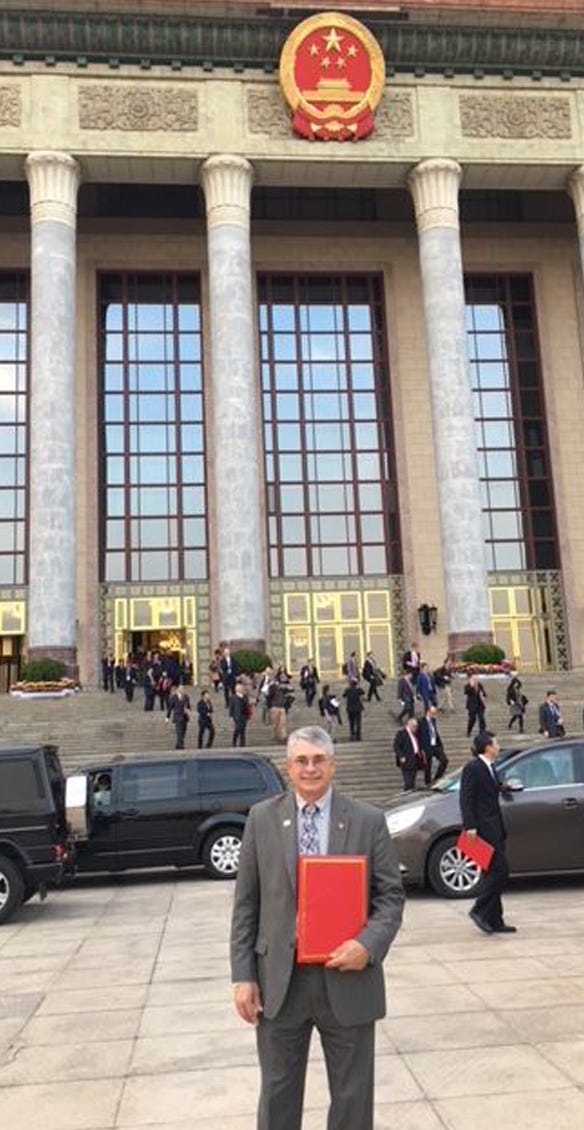
It was a historic trip for Belden, Neb., farmer and U.S. Soybean Export Council chairman Jim Miller. During President Donald Trump's early November trip to Asia, which included China, Miller, who is also an American Soybean Association director, represented the U.S. soy industry during two signing ceremonies in Beijing.
On Nov. 8, USSEC, representing 10 U.S. soy exporters, signed a letter of intent with China Chamber of Commerce for Import and Export of Foodstuffs, Native Produce and Animal Byproducts representing 10 Chinese importers. The signing, which was attended by U.S. Secretary of Commerce Wilbur Ross and China's Vice Premier Wang Yang, represented 8 million metric tons of U.S. soybeans valued at $3.4 billion. The following day, Miller participated in another signing ceremony, this time witnessed by Trump and Chinese President Xi.
The second signing represented an agreement between ADM and Cofco for 4 million metric tons of U.S. soybeans, valued at $1.6 billion. So far, Chinese buyers have committed to buy a total of $11.57 billion worth of soybeans through three signing ceremonies for the 2017-2018 marketing year.
We caught up with Miller after he returned home to Belden and asked him about this China trade trip and the signing ceremonies he participated in. Here is what Miller wanted farmers to know.
Why are these agreements so crucial to our bottom line?
"Events such as these help us to build relationships with our international customers. China is our No. 1 customer, taking just over 30% of all soybeans we raise here in the U.S. Through participation in this trade mission, USSEC was able to highlight the importance of the bilateral trade in soybeans to both the Chinese and U.S. governments. These two signing events represented 12 MMT of soybeans valued at $5 billion.
What issues were discussed with the Chinese during this trade trip?
Prior to the signing, USSEC held a roundtable discussion with Chinese importers to talk about concerns each of us may have. The two main concerns from China were the foreign-matter content of U.S. soybeans compared to soy from South America, and how slow the Chinese government is at issuing safety certificates to importers.
On FM content, South American contracts are based on 1% FM content and U.S. contracts are based on 2%. China received a couple of loads from the U.S. this past year at 3.4% and 4% FM. When I was in China in September 2017, the Chinese Ministry of Agriculture and Commerce told us if the U.S. uses the Section 301 trade adjustment against Chinese products, they would retaliate against soybeans. Section 301 of the U.S. Trade Act authorizes the president to take all appropriate action, including retaliation, to obtain the removal of any act, policy or practice of a foreign government that violates an international trade agreement or that burdens U.S. commerce.
I let them know that this would not only hurt U.S. soybean farmers, but it would also hurt their own crushing industry, of which 40% is owned by the government. It would also hurt their livestock industry because it would raise the price of soybeans to livestock producers if they had to source all of their soy from one region.
The other concern USSEC raised is the slow approval process for new genetic seed traits in China. If new traits were approved, it would help us with weed resistance issues that are developing, thus helping to lower weed seed and FM content.
What does the future hold for U.S. soy in the Chinese markets?
Today, it takes what the world grows to meet the needs of soy protein around the globe. ASA opened their office in Beijing in 1982, but it took until 1995 before China bought the first soybeans from the U.S., a contract for 400,000 metric tons. Last year, the Chinese imported 36 MMT from the U.S. and a total of 90 MMT from the world supply. It is projected that the demand for soy will grow to 103 MMT by the year 2020. We expect the economy in China to grow, incomes to increase and urbanization to expand. These trends along with President Xi's goals to eliminate poverty will lead to increased demand and consumption of animal protein and vegetable oil, which will lead to increased imports of U.S. soybeans.
What brought you the greatest satisfaction on the trip, and what are some future concerns about trade with China?
The biggest successes came with $253 billion in U.S. products that were committed to be purchased by China. This will help reduce the trade deficit that President Trump is concerned about. The other thing was the good relationship between President Trump and President Xi. It was a real honor to represent the U.S. soybean industry at an event like this. USSEC was one out of 28 companies that were asked by the U.S. Department of Commerce to participate in the presidential trade mission. Both Presidents Trump and Xi talked about the good relationship they have developed with meeting at Mar-a-Lago in the U.S. and now in Beijing. They both said they wanted to work on balancing the trade deficit. President Trump didn't deride China for having such a surplus of trade, but he related disappointment in the administrations before him for allowing such a trade deficit to happen.

WORTH BILLIONS: Jim Miller, chairman of the USSEC, participated in two historic signing ceremonies where the Chinese government promised to purchase 12 MMT of soybeans worth $5 billion. Here, Miller poses in front of the Great Hall of the People where the ceremonies took place, holding one letter of intent from the Chinese valued at $3 billion in U.S. soybeans to be purchased.

A concern came up during a breakfast meeting with the U.S. delegation of CEOs, when U.S. Commerce Secretary Ross talked about how the U.S. may have to use Section 301 trade adjustment to help balance this trade deficit. As a director of ASA, we are part of a group called the Food and Agriculture Dialogue for Trade, which is working to educate our administration about the importance of agriculture trade and the implications if Section 301 would be used or if we were to pull out of the North American Free Trade Agreement or the U.S.-Korean Trade Agreement.
You can learn more about Miller's experiences and the China trade mission by going online at ussec.org.
About the Author(s)
You May Also Like






